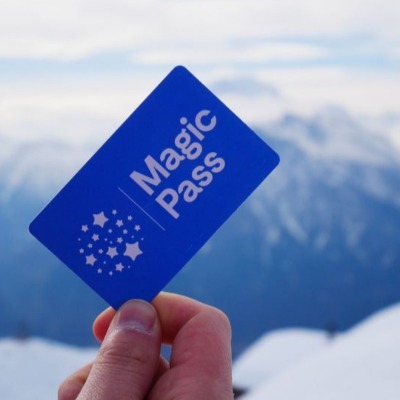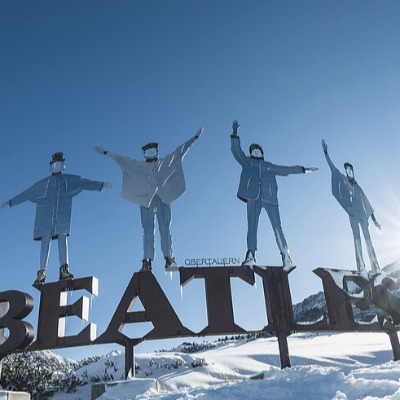Destimetrics - January Bookings Soar With Big Snow & Stable Room Rates; Occupancy Still Lagging

Buoyed by generous snowfall across most western destinations, the booking pace for guests arriving in January through June rose 13.3 percent compared to the same time last year which boosted the aggregated occupancy for those six months 7.1 percent. The monthly Market Briefing released by DestiMetrics* last week–part of the Business Intelligence division of Inntopia—also revealed that although this is the second consecutive month for an increase in bookings, total occupancy for the season remains lower than last year at this time in a year-over-year comparison. More than 28,000 lodging units located in 17 mountain communities across seven western states contributed data through Jan. 31 for the monthly summary.
January moves ahead of previous three years
Many school holidays that were shifted into early January this year get some of the credit, along with abundant snowfall, for the strong January results. Compared to last January, occupancy was up 10.1 percent while the Average Daily Rate (ADR) rose 11.3 percent for a 22.1 percent increase in revenues compared to January 2022. Looking back two years ago when the pandemic was still raging and vaccines were just emerging, occupancy for the month was up a strong, but not surprising 50.6 percent with ADR up an equally impressive 57.2 percent for a whopping 136.6 percent increase in revenue from January 2021. And even when comparing to the pre-pandemic month of January in 2020, occupancy was still up 4.9 percent over that more typical January while ADR is up a striking 34.9 percent compared to three years ago to deliver revenues that were 41.5 percent higher than January 2020.
Snow, and more snow, solidifying the season
At the halfway point of the season, occupancy is gradually clawing back some of the declines experienced during the fall and early winter booking season. As of Jan. 31, on-the-books occupancy for November through April is down a scant 1.4 percent compared to last year at this time and marks the second consecutive month where occupancy improved from the previous month—when it was down 3.8 percent as of Dec. 31—and down 5.6 percent compared to Nov. 30. However, January is still the only month this winter with a year-over-year increase—that healthy 10.1 percent and is well ahead of one month ago when it was up barely over one percent. Strong daily rates are once again helping to offset the lower occupancy as the winter ADR is up eight percent for a seasonal increase in revenue of 6.4 percent.
“There is no question that great snowfall always helps move the needle in getting people to book a winter vacation, but that doesn’t entirely explain all the dynamics going on this winter,” observed Tom Foley, senior vice president of Business Intelligence for Inntopia. “Besides widespread snow, a significant number of public schools had their holiday breaks shifted from pre-Christmas to the week after New Year’s so that moved a lot of bookings to that typically slower week,” he continued. “And last January, the Omicron variant was having a big impact on travel plans as cases surged so this year’s comparison is against a less-than-stellar January last year.”
Not surprisingly, when compared to the first full pandemic winter of 2020-21, occupancy was up 46.8 percent, daily rates are up 47.6 percent, and revenues are up a dramatic, but expected, 116.7 percent. Looking back to three years ago, occupancy is up 4.4 percent with moderate gains in all six months while ADR is up a strong 38.2 percent. That combination of higher occupancy and much higher rates is providing a 44.2 percent increase in aggregated revenues.
Foley went on to tick off several other variables that are shaping this season including high inflation and rising interest rates, the war in Ukraine, consumer uncertainty, and rising room rates which are nudging some overnight visitors into fewer or shorter stays.
Econometrics
The Dow Jones Industrial Average (DJIA) made a moderate rebound from December’s closing and rose 2.83 percent to finish up 938.8 points and marking the third gain in the past six months. However, it is 7.2 percent higher than its 2022 low recorded in October. Investors reacted positively to better-than-expected inflation numbers and strong jobs data which and that strong jobs report likely prompted the Federal Reserve Bank to continue raising interest rates, but at a slower pace. Many analysts are now projecting that a recession, if one occurs, will likely be a weak downturn. “The direction of Wall Street matters because stronger financial markets support increased or stable consumer savings and that, in turn, supports discretionary spending on things like travel,” explained Foley.
The Consumer Confidence Index (CCI) and the Consumer Sentiment Index (CSI) delivered a mixed message during January. The CCI dipped 1.7 percent to finish at 107.1 points and marks the third decline in the last six months. In sharp contrast, the University of Michigan’s CSI rose a strong 8.7 percent to 64.9 points. While still hovering near historic low historic levels including the low of 50.0 points in June 2022, the index is slowly edging back up.
“Consumers cited strong earnings and easing price pressure as major reasons for the gain in sentiment and since this index is often a leading indicator of confidence, we’ll be watching closely to see if this increase spills over onto the CCI next month,” continued Foley.
The national Unemployment Rate dropped to 3.4 percent during January to reach its lowest level since 1969 as employers added an astounding, and completely unexpected, 517,000 new jobs. Foley explained that this is actually a good/bad situation. “On the positive side, it shows that consumers are still actively engaged in the economy and making purchases which forces employers to add jobs to accommodate consumer demand. But the downside is that all that commerce indicates the economy is not slowing down enough to curb inflation, and that cues the Federal Reserve to continue raising interest rates—which makes borrowing and debt repayment more expensive,” he clarified. “Equally significant is that the Leisure and Hospitality industry accounted for 128,000 of those jobs with 15,000 of the positions in lodging and accommodations—and while that was fewer than hoped, it should help ease some of the current limitations in lodging capacity due to an insufficient workforce,” he pointed out.
The national Inflation Rate was down to 6.5 percent in December and has been trending down for six consecutive months to be well below the 9.1 percent high recorded back in June. And while gasoline prices have decreased dramatically in the past few months, despite a slight bump up in the last 30 days, home energy and food prices remain stubbornly high.
Watching closely
*Widespread snowfall gave a much-needed boost to January bookings and occupancy and the deep accumulations being experienced in many destinations, particularly the Sierras, will allow for a stronger mid-season and extended late season—likely to exceed the past few years.
*Winter occupancy continued to make gains during the month and as of Jan. 31, the overall decline was only down 1.4 percent compared to 3.8 percent at the end of the December—and much improved from the 6.2 percent decline being reported at the end of last October.
*Lead Times—the number of days before arrival that a reservation is booked—increased in January to an average of 51.2 days as consumers anticipated good snow conditions stretching later into this season compared to last year. This is the strongest January lead time in four years and is a full eleven days longer than in January 2021.
*Length-of-Stay continued to shrink to pre-pandemic levels during January and is now just 0.22 nights longer than at this time three years ago. This is a steep decline from the 1.3-night gain that was being reported one year ago at this time. This illustrates that more workers are back in offices with less flexibility than during the pandemic.
“There is no question that big snow makes a big difference in how a season progresses and it always offsets many of the challenges of a soft or erratic economy,” emphasizes Foley. “And as encouraging as the data looks this month, there are still several variables in the equation that make it trickier to draw true ‘apples-to-apples’ comparisons. January bookings were great, but part of that big jump had to do with the Omicron variant surging last year at this time when bookings were dropping. We are also still seeing shifting amounts of available inventory as some units are no longer being professionally managed and aren’t included in the data or owners have simply taken them out of the rental pool entirely which is reducing the number of available units for rent,” he continued.
Foley’s mid-season summary was optimistic. “Given where we were in October with a weak booking pace, very high inflation, interest rate hikes, weak consumer confidence, a volatile economy, and predictions for a wet and warm winter, things are turning around very impressively. Barring any unforeseen disruption, this is shaping up to be one of the strongest winter seasons ever for mountain lodging properties,” he concluded.













